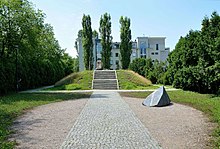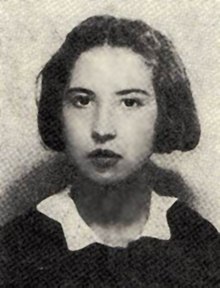Mordechaj Anielewicz
Mordechaj Anielewicz (born 1919 in Wyszków , Poland ; died May 8, 1943 in Warsaw ) was a Polish-Jewish fighter in the resistance against National Socialism in Germany-occupied Poland during World War II .
As the leader of the Warsaw group of the Zionist - socialist youth organization Hashomer Hatzair , Anielewicz was significantly involved in the development of the Jewish combat organization (Polish: Żydowska Organizacja Bojowa , abbreviated ŻOB) in the Warsaw ghetto from 1942 onwards . There he led the uprising in the Warsaw Ghetto in 1943 , the inmates of which were scheduled for deportation to the Treblinka extermination camp . In the final phase of this uprising, which lasted about four weeks between mid-April and mid-May 1943, he fell victim to the ultimately militarily superior units of the SS and Waffen-SS, like most of his fellow combatants, who comprised around 1,000 to 1,300 people .
Life
Mordechaj Anielewicz joined the socialist - Zionist youth movement HaSchomer HaTzair soon after graduating from secondary school , where he was given organizational and managerial tasks. At the beginning of 1940 he founded as an activist in the underground youth groups and illegal newspapers. In the summer of 1941 Anielewicz began to transform the youth movements from the underground into an armed resistance movement and to set up self-help organizations in the Warsaw ghetto .
In the summer of 1942 he was in the south-western part of Poland, which had been occupied by Nazi Germany in 1939 and formed part of the Polish General Government. After his return to Warsaw, of the original 350,000 Jews in the ghetto, only 60,000 remained, the rest of the majority had been deported to the Treblinka extermination camp . Anielewicz did everything in his power to strengthen the Jewish Fighting Organization ( Żydowska Organizacja Bojowa in Polish , ŻOB for short) and actively fought against the National Socialists. After the mass deportations, there was significantly more support for the armed resistance in the ghetto than ever before. In November 1942 Anielewicz was appointed commander of the Jewish combat organization. Up until January 1943, firearms and ammunition were occasionally organized outside the ghetto in other parts of Warsaw through various channels (black market, contacts with Polish resistance groups in the underground) and smuggled into the ghetto at considerable risk for those involved.
On January 18, 1943, the staff of the OOB was surprised by the second mass deportations from the Warsaw ghetto and had no time to report the situation. Anielewicz commanded a major street battle. Some fighters deliberately joined the deportees. Upon receiving a signal, they attacked the SS guards while the rest of the Jews fled. Many Jewish resistance fighters died, but Anielewicz stayed alive.
Four days later the deportations came to a standstill. As it was clear to the staff of the OOB that they could only stop the deportations temporarily, they prepared intensively for the next clash with the SS.
The last deportation of the Jews was ordered on April 19, 1943. This was the signal for the real main phase of the uprising in the Warsaw ghetto . First of all, the Jewish resistance fighters inflicted such losses on the SS and Waffen-SS, which were under the command of SS-Gruppenführer Jürgen Stroop , that they felt compelled to retreat. After the reinforced German troops returned with heavier equipment, the house-to-house fighting lasted three days.
At the beginning of the uprising, Anielewicz was in the middle of the main group of fighters. When the house-to-house fighting ended and the street fighting turned more and more to the disadvantage of the insurgents and after the SS had started to deploy more massive troop contingents against the remaining Jewish fighters, he withdrew with his staff into one of the 16 or so bunkers, most of which were set up by the insurgents back at 18 Miłastraße. The SS burned the ghetto block by block. On May 8, 1943, Anielewicz died with his girlfriend Mira Fuchrer and most of his ŻOB staff in the bunker at Miła 18 . The exact circumstances of his death are unknown, as no surviving eyewitnesses are known, and the dead were not officially recovered. In some cases it is assumed that there was a collective suicide , others assume that those trapped in the bunker were suffocated by the exhaust gases introduced by the Germans. The whereabouts of Anielewicz's body is also controversial. The assumption that some of the survivors recovered the corpses or part of them and gave them a form of burial in a nearby crematorium cannot be clearly verified. Many of them were buried under the ghetto ruins.
In a suicide note to a friend, Anielewicz wrote on April 23, 1943 (excerpt):
“Go well, my friend! Maybe we'll see each other again! The dream of my life has come true. The armed Jewish resistance and revenge have become an act. I have witnessed wonderful heroic fighting by the Jewish fighters. "
Commemoration and reception

In 1946, one year after the end of the Second World War and the liberation from National Socialism , a hill was raised from the rubble of the burned down Warsaw ghetto over the bunker of Miła 18 and on top of it a memorial in the form of an obelisk in memory of Anielewicz and his fighters built. In addition to the naming of Mordechaj Anielewicz, the names of 50 other insurgents are engraved on it, who died with him there, and whose identity has been verified by historians.

The kibbutz Jad Mordechai in Israel , which was founded in 1943, the year he died, is also dedicated to the memory of Mordechaj Anielewicz . In addition, numerous streets in Israel are named after him. On the Warsaw Ghetto Square in Yad Vashem in Jerusalem , the most important memorial that commemorates the National Socialist genocide of European Jews , there is a copy of the Warsaw Memorial to commemorate the Ghetto Uprising, on which Anielewicz appears as the central heroic figure is shown. In addition to the aforementioned Warsaw monuments, a street there bears his name. There is a memorial at his birthplace with inscriptions in Polish, Hebrew and English.
See also
literature
- Sabine Gebhardt-Herzberg: The song is written with blood and not with lead. Mordechaj Anielewicz and the uprising in the Warsaw Ghetto , self-published, Bielefeld 2003. ISBN 3-00-013643-6 .
Web links
- Literature by and about Mordechaj Anielewicz in the catalog of the German National Library
- Short biography of the German Resistance Memorial Center
- Sabine Gebhardt-Herzberg: Mordechaj Anielewicz: Commander of the uprising in the Warsaw ghetto. In: Shoah.org (Preface to the book The song is written with blood and not with lead - Mordechaj Anielewicz and the Warsaw Ghetto Uprising , 2003).
- Mordechai Anielewicz. In: A Teacher's Guide to the Holocaust (English)
Notes / individual evidence
- ^ Simha Rotem (Kazik): Memoirs of a Warsaw Ghetto Fighter . Yale University Press, New Haven / London 1994, ISBN 0-300-05797-0 , p. 41.
- ↑ quoted from: Letters from the Shoah. Edited by Walter-Zwi Bacharach, on behalf of the Yad Vashem Memorial , translated from the Hebrew by Maurice Tszorf. Wallstein Verlag, Göttingen 2006. ( online at www.yadvashem.org (PDF file))
| personal data | |
|---|---|
| SURNAME | Anielewicz, Mordechaj |
| BRIEF DESCRIPTION | Polish-Jewish resistance fighter, leader of the Warsaw Ghetto uprising |
| DATE OF BIRTH | 1919 |
| PLACE OF BIRTH | Wyszków |
| DATE OF DEATH | May 8, 1943 |
| Place of death | Warsaw , Poland |


